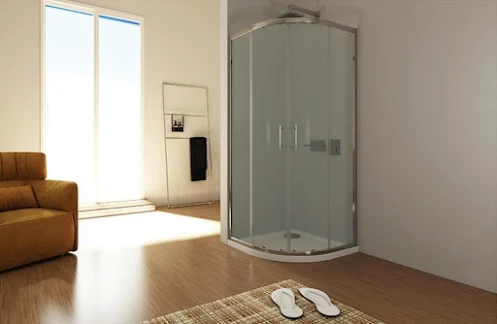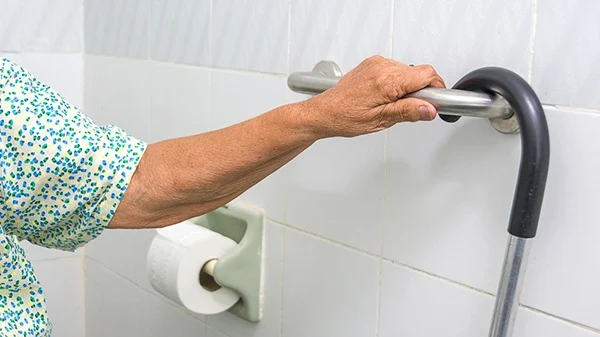It is generally accepted that elders who live in their own homes provide the best quality of care. However, bathrooms and other areas can make the home a hazardous environment. You may have a greater chance of your loved one falling if they are in need of dementia care or have mobility issues. These are some ways to make your loved ones' bathroom safer.
1. Tiles and Anti-Slip Mats
The majority of falls happen in the shower or bathtub. An anti-slip rug is a good choice because the area gets lots of soap and water. These can be used next to the sink, near the toilet's entrance and the toilet.
If you're building a bathroom from scratch, install slip-resistant tiles. This can be used in all rooms or in the shower. An anti-slip coating enhances safety.
Non-slip adhesive taps can be helpful as well, mainly when placed around the basin's boundaries. They keep the hand from sliding if the hands grab the tape for balance. These tape strips could be used visually to limit slippery areas.
2. Grab bars & bath seats
Add grab bars to your bathroom and it will become a safe place for the elderly. These bars can hold the entire weight of an adult as they are fixed to the wall by metal studs or suction cups. These are portable solutions that can also be used elsewhere in your house.
To make it easy for your elderly parent to use the shower, install grab bars near the commode so that they can quickly get in and get out. Floor-to-ceiling tension bars are an option if your senior parent needs help.
Shower chairs with rubber leg tips can make standing for prolonged periods of time uncomfortable. A handheld shower with an extended hose is a great option to make their experience more comfortable.
3. Colour and lighting
Overhead lighting is the ideal way to lighten a bathroom. This is often misunderstood. The overhead lighting can cause shadows, which can make it dangerous for elderly people. It also doesn't evenly illuminate certain areas such as behind shower curtains or under cabinets.
Bathrooms should have multiple lights to ensure they are well lit. In order to ensure that the bathroom is well lit, separate lights should be used at the sink and mirror, as well as the shower and, perhaps most importantly, the pathway leading into it.
Use contrasting colours to mark distinct areas in the bathroom. Avoid high-gloss colours and favour matte shades. They can cause a perplexing glare. This is a minor step that can improve your visual perception.
4. Walk-in Bath
If your relative is older and has trouble getting in and out of a bath, a walk-in bath might be the best option. Instead of having to climb over the edge as in regular bathtubs, these bathtubs feature a door that opens which allows you to walk in and then sit down. This door opens and allows for falls to be significantly reduced. Even if your loved one is provided with 24-hour care, they will likely prefer to bathe in their own bathroom, which a walk-in bath can allow.
5. Shower Chair
Shower chairs are great for those with balance problems, who like to take showers, but need stability. Non-slip rubber tips should be placed on the legs of your shower chair to keep it from sliding. For those with mobility problems or health issues, a simple stool can be used in the tub.
6. Water Temperature
Scalding can be dangerous for elderly persons who have limited movement or sensory deficits. If you are concerned that your loved one may be at risk, ensure the temperature of the shower and bath is not above 44 degrees Celsius.
7. Handheld shower
Elders can take a shower while standing or sitting with the easy-to-install handheld head.
2. Include doors that swing open. This will provide easy access in the case of an elderly person falling on the door.
3. To ensure they don’t burn themselves or get cold, label the hot-water and cold-water handlers.
4. Do not walk up to the door if you notice a lip or hump.
5. The bathroom should not be cluttered and provide enough space for people to walk around.
These little improvements can make it possible to reduce the chance of accidents and provide seniors with some peace of mind. They will be able to live independently in their own home and with confidence.
1. Tiles and Anti-Slip Mats
The majority of falls happen in the shower or bathtub. An anti-slip rug is a good choice because the area gets lots of soap and water. These can be used next to the sink, near the toilet's entrance and the toilet.
If you're building a bathroom from scratch, install slip-resistant tiles. This can be used in all rooms or in the shower. An anti-slip coating enhances safety.
Non-slip adhesive taps can be helpful as well, mainly when placed around the basin's boundaries. They keep the hand from sliding if the hands grab the tape for balance. These tape strips could be used visually to limit slippery areas.
2. Grab bars & bath seats
To make it easy for your elderly parent to use the shower, install grab bars near the commode so that they can quickly get in and get out. Floor-to-ceiling tension bars are an option if your senior parent needs help.
Shower chairs with rubber leg tips can make standing for prolonged periods of time uncomfortable. A handheld shower with an extended hose is a great option to make their experience more comfortable.
3. Colour and lighting
Overhead lighting is the ideal way to lighten a bathroom. This is often misunderstood. The overhead lighting can cause shadows, which can make it dangerous for elderly people. It also doesn't evenly illuminate certain areas such as behind shower curtains or under cabinets.
Bathrooms should have multiple lights to ensure they are well lit. In order to ensure that the bathroom is well lit, separate lights should be used at the sink and mirror, as well as the shower and, perhaps most importantly, the pathway leading into it.
Use contrasting colours to mark distinct areas in the bathroom. Avoid high-gloss colours and favour matte shades. They can cause a perplexing glare. This is a minor step that can improve your visual perception.
4. Walk-in Bath
 |
| Image Credit: Tapron |
If your relative is older and has trouble getting in and out of a bath, a walk-in bath might be the best option. Instead of having to climb over the edge as in regular bathtubs, these bathtubs feature a door that opens which allows you to walk in and then sit down. This door opens and allows for falls to be significantly reduced. Even if your loved one is provided with 24-hour care, they will likely prefer to bathe in their own bathroom, which a walk-in bath can allow.
5. Shower Chair
Shower chairs are great for those with balance problems, who like to take showers, but need stability. Non-slip rubber tips should be placed on the legs of your shower chair to keep it from sliding. For those with mobility problems or health issues, a simple stool can be used in the tub.
6. Water Temperature
Scalding can be dangerous for elderly persons who have limited movement or sensory deficits. If you are concerned that your loved one may be at risk, ensure the temperature of the shower and bath is not above 44 degrees Celsius.
7. Handheld shower
Elders can take a shower while standing or sitting with the easy-to-install handheld head.
1. In case of an emergency, you can have a telephone. You should make sure that the phone is waterproof and that it is at a comfortable height.
2. Include doors that swing open. This will provide easy access in the case of an elderly person falling on the door.
3. To ensure they don’t burn themselves or get cold, label the hot-water and cold-water handlers.
4. Do not walk up to the door if you notice a lip or hump.
5. The bathroom should not be cluttered and provide enough space for people to walk around.
These little improvements can make it possible to reduce the chance of accidents and provide seniors with some peace of mind. They will be able to live independently in their own home and with confidence.


Comments
Post a Comment